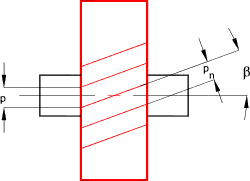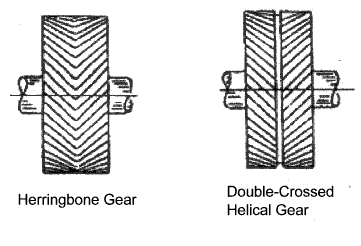How To Find Helix Angle Of Helical Gear
Helical gears are similar to spur gears except that the gears teeth are at an angle with the axis of the gears. A helical gear is termed right handed or left handed as adamant by the direction the teeth slope away from the viewer looking at the tiptop gear surface forth the axis of the gear. ( Alternatively if a gear rests on its face the mitt is in the direction of the gradient of the teeth) . Meshing helical gears must be of opposite manus. Meshed helical gears can be at an angle to each other (upward to 90o ). The helical gear provides a smoother mesh and can be operated at greater speeds than a straight spur gear. In operatation helical gears generate axial shaft forces in improver to the radial shaft force generated by normal spur gears.
In operation the initial tooth contact of a helical gear is a bespeak which develops into a full line contact as the gear rotates. This is a smoother cycle than a spur which has an initial line contact. Spur gears are generally non run at peripheral speed of more than 10m/s. Helical gears tin be run at speed exceeding 50m/s when accurately machined and balanced.
- AGMA 2001-C95 or AGMA-2101-C95 Key Rating factors and Calculation Methods for involute Spur Gear and Helical Gear Teeth
- BS 436-iv:1996, ISO 1328-1:1995..Spur and helical gears. Definitions and allowable values of deviations relevant to corresponding flanks of gear teeth
- BS 436-5:1997, ISO 1328-two:1997..Spur and helical gears. Definitions and commanded values of deviations relevant to radial composite deviations and runout data
- BS ISO 6336-1:1996 ..Calculation of load capacity of spur and helical gears. Basic principles, introduction and general influence factors
- BS ISO 6336-2:1996..Calculation of load capacity of spur and helical gears. Adding of surface durability (pitting)
- BS ISO 6336-3:1996..Calculation of load capacity of spur and helical gears. Calculation of molar bending strength
- BS ISO 6336-5:2003..Calculation of load capacity of spur and helical gears. Strength and quality of materials
Helical gear parameters
A helical gear train with parallel axes is very like to a spur gear with the aforementioned tooth contour and proportions. The primary difference is that the teeth are machined at an bending to the gear axis.

The helix angle of helical gears β is generally selected from the range six,8,10,12,xv,20 degrees. The larger the angle the smoother the move and the higher speed possible yet the thrust loadings on the supporting bearings also increases. In case of a double or herringbone gear β values 25,30,35,40 degrees tin can besides be used. These large angles tin can be used because the side thrusts on the two sets of teeth cancel each other allowing larger angles with no punishment
For helical gears the circular pitch is measured in two ways
The traverse round pitch (p) is the same as for spur gears and is measured along the pitch circle
The normal round pitch p n is measured normal to the helix of the gear.
The diametric pitch is the same as for spur gears ... P = z g /dg = z p /d p ....d= pitch circumvolve dia (inches).
The module is the same as for spur gears ... 1000 = dg/z m = d p/z p.... d = pitch circumvolve dia (mm).
- p = Circular pitch = d g. p / z g = d p. p / z p
- p n = Normal circular pitch = p .cosβ
- P n =Normal diametrical pitch = P /cosβ
- p ten = Axial pitch = p c /tanβ
- chiliad n =Normal module = thou / cosβ
- α n = Normal pressure angle = tan -1 ( tanα.cos β )
- β =Helix angle
- d g = Pitch diameter gear = z thousand. m
- d p = Pitch diameter pinion = z p. m
- a =Heart distance = ( z p + z chiliad )* m n /2 cos β
- a a = Addendum = m
- a f =Dedendum = i.25*m
- b = Face width of narrowest gear
Herringbone / double crossed helical gears

When ii helical gears are used to transmit power between non parallel, non-intersecting shafts, they are generally called crossed helical gears. These are simply normal helical gears with non-parallel shafts. For crossed helical gears to operate successfully they must have the same pressure angle and the same normal pitch. They need non take the same helix angle and they do non need to exist contrary manus. The contact is not a expert line contact as for parallel helical gears and is often little more than than a bespeak contact. Running in crossed helical gears tend to marginally meliorate the area of contact.
The relationship between the shaft angles
E and the helix angles β 1 & βii is equally follows
Due east = (Same Helix Angle) β ane + β 2 ......(Reverse Helix Bending) β ane - β 2

The centres distance (a) between crossed helical gears is calculated as follows
a = m * [(z ane / cos β one) + ( z i / cos β 1 )] / 2
The sliding velocity 5southof crossed helical gears is given by
Vsouth = (V1 / cos β 1 ) = (V ii / cos β 2 )
Strength and Durability calculations for Helical Gear Teeth
Designing helical gears is commonly washed in accordance with standards the two most popular serial are listed under standards above: The notes below chronicle to approximate methods for estimating gear strengths. The methods are really only useful for commencement approximations and/or selection of stock gears (ref links below). � Detailed design of spur and helical gears should best be completed using :
a) Standards.
b) Books are available providing the necessary guidance.
c) Software is also available making the process very easy. A very reasonably priced and easy to utilize package is included in the links beneath (Mitcalc.com)
The determination of the capacity of gears to transfer the required torque for the desired operating life is completed past determining the strength of the gear teeth in angle and also the durability i.eastward of the teeth ( resistance to wearing/bearing/scuffing loads ) .. The equations beneath are based on methods used by Buckingham..
Bending
The Lewis formula for spur gears can be applied to helical gears with minor adjustments to provide an initial bourgeois gauge of gear strength in angle. This equation should only be used for first estimates.
σ = Fb / ( ba. m. Y )
- Fb = Normal force on tooth = Tangential Force Ft / cos β
- σ = Tooth Bending stress (MPa)
- ba = Face width (mm)
- Y = Lewis Form Factor
- m = Module (mm)
When a gear bike is rotating the gear teeth come into contact with some caste of impact. To allow for this a velocity cistron is introduced into the equation. This is given by the Barth equation for milled profile gears.
K v = (6,i + 5 ) / 6,one
5 = the pitch line velocity = PCD.w/2
The Lewis formula is thus modified every bit follows
σ = One thousand v.Fb / ba. m. Y
The Lewis class gene Y must be determined for the virtual number of teeth z' = z /cos3β The bending stress resulting should exist less than the allowable bending stress Sb for the gear material under consideration. Some sample values are provide on this page ef Gear Strength Values
Surface Strength
The allowable gear force from surface durability considerations is determined approximately using the unproblematic equation as follows
Fwestward = Yard 5 d p b a Q G / cos2β
![]()
Q = 2. dg /( dp + dp ) = two.zg /( zp +zp )
Fw = The commanded gear load. (MPa)
K = Gear Wear Load Cistron (MPa) obtained by look upwards ref Gear Strength Values
| Lewis Class factor for Teeth profile α = 20o , addendum = k, dedendum = ane.25m | |||||||||
| Number of teeth | Y | Number of teeth | Y | Number of teeth | Y | Number of teeth | Y | Number of teeth | Y |
| 12 | 0.245 | 17 | 0.303 | 22 | 0.331 | 34 | 0.371 | 75 | 0.435 |
| xiii | 0.261 | xviii | 0.309 | 24 | 0.337 | 38 | 0.384 | 100 | 0.447 |
| xiv | 0.277 | 19 | 0.314 | 26 | 0.346 | 45 | 0.401 | 150 | 0.460 |
| 15 | 0.290 | xx | 0.322 | 28 | 0.353 | fifty | 0.409 | 300 | 0.472 |
| sixteen | 0.296 | 21 | 0.328 | 30 | 0.359 | 60 | 0.422 | Rack | 0.485 |
Source: https://roymech.org/Useful_Tables/Drive/Helical_Gears.html
Posted by: gentryfamenjusich.blogspot.com


0 Response to "How To Find Helix Angle Of Helical Gear"
Post a Comment